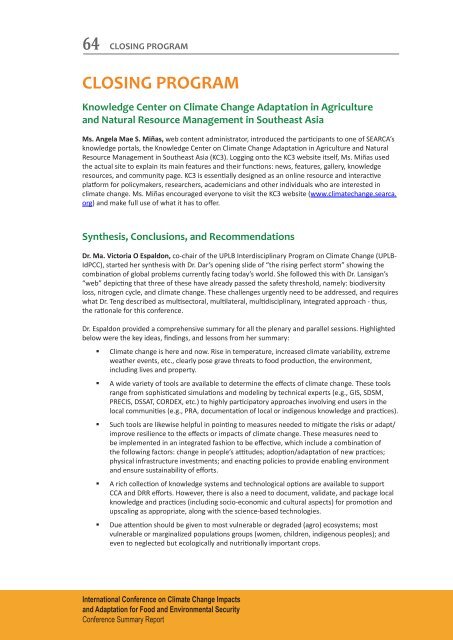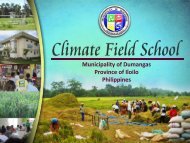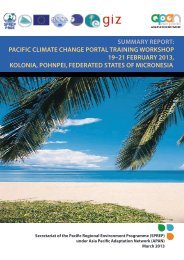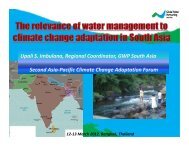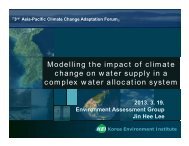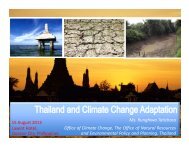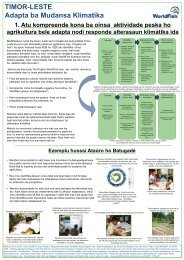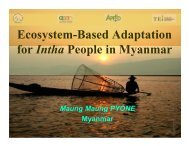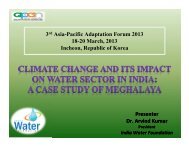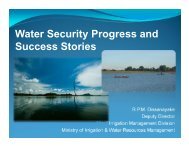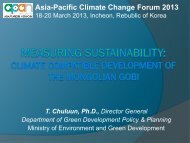PDF file (2.44 MB) - Asia Pacific Adaptation Network
PDF file (2.44 MB) - Asia Pacific Adaptation Network
PDF file (2.44 MB) - Asia Pacific Adaptation Network
Create successful ePaper yourself
Turn your PDF publications into a flip-book with our unique Google optimized e-Paper software.
64CLOSING PROGRAMCLOSING PROGRAMKnowledge Center on Climate Change <strong>Adaptation</strong> in Agricultureand Natural Resource Management in Southeast <strong>Asia</strong>Ms. Angela Mae S. Miñas, web content administrator, introduced the participants to one of SEARCA’sknowledge portals, the Knowledge Center on Climate Change <strong>Adaptation</strong> in Agriculture and NaturalResource Management in Southeast <strong>Asia</strong> (KC3). Logging onto the KC3 website itself, Ms. Miñas usedthe actual site to explain its main features and their functions: news, features, gallery, knowledgeresources, and community page. KC3 is essentially designed as an online resource and interactiveplatform for policymakers, researchers, academicians and other individuals who are interested inclimate change. Ms. Miñas encouraged everyone to visit the KC3 website (www.climatechange.searca.org) and make full use of what it has to offer.Synthesis, Conclusions, and RecommendationsDr. Ma. Victoria O Espaldon, co-chair of the UPLB Interdisciplinary Program on Climate Change (UPLB-IdPCC), started her synthesis with Dr. Dar’s opening slide of “the rising perfect storm” showing thecombination of global problems currently facing today’s world. She followed this with Dr. Lansigan’s“web” depicting that three of these have already passed the safety threshold, namely: biodiversityloss, nitrogen cycle, and climate change. These challenges urgently need to be addressed, and requireswhat Dr. Teng described as multisectoral, multilateral, multidisciplinary, integrated approach - thus,the rationale for this conference.Dr. Espaldon provided a comprehensive summary for all the plenary and parallel sessions. Highlightedbelow were the key ideas, findings, and lessons from her summary:• Climate change is here and now. Rise in temperature, increased climate variability, extremeweather events, etc., clearly pose grave threats to food production, the environment,including lives and property.• A wide variety of tools are available to determine the effects of climate change. These toolsrange from sophisticated simulations and modeling by technical experts (e.g., GIS, SDSM,PRECIS, DSSAT, CORDEX, etc.) to highly participatory approaches involving end users in thelocal communities (e.g., PRA, documentation of local or indigenous knowledge and practices).• Such tools are likewise helpful in pointing to measures needed to mitigate the risks or adapt/improve resilience to the effects or impacts of climate change. These measures need tobe implemented in an integrated fashion to be effective, which include a combination ofthe following factors: change in people’s attitudes; adoption/adaptation of new practices;physical infrastructure investments; and enacting policies to provide enabling environmentand ensure sustainability of efforts.• A rich collection of knowledge systems and technological options are available to supportCCA and DRR efforts. However, there is also a need to document, validate, and package localknowledge and practices (including socio-economic and cultural aspects) for promotion andupscaling as appropriate, along with the science-based technologies.• Due attention should be given to most vulnerable or degraded (agro) ecosystems; mostvulnerable or marginalized populations groups (women, children, indigenous peoples); andeven to neglected but ecologically and nutritionally important crops.International Conference on Climate Change Impactsand <strong>Adaptation</strong> for Food and Environmental SecurityConference Summary Report


